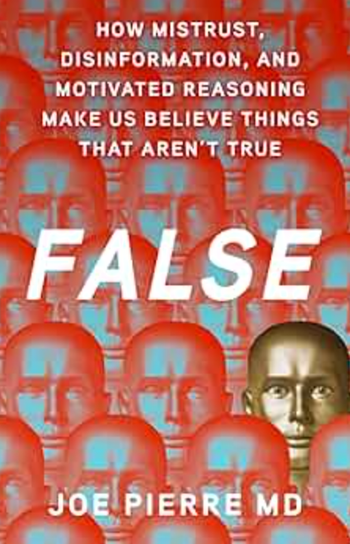
- Vol 34 No 11
- Volume 34
- Issue 11
IT: On the Unheimlich Maneuvers of Stephen King
King is singularly adept at capturing the vicissitudes, mores, and speech of pre-teenagers (particularly boys) throughout his writing-most notably in one of his longest novels, IT.
GreenbergOnTheArts
The uncanny eludes facile definition. Savants diverse as Nietzsche, Poe, Freud, and Jung have had a go at those mysterious creeps that prick up your hair and unsettle your mind. However trenchant, speculations about the nature and causes of the uncanny somehow end up wide of the mark.
At base, uncanny experiences are rooted in the realm of the unconscious-individual or collective (if your bent is Jungian). And the workings of the unconscious sui generis refuse tidy explanation because they’re recoverable only in conscious “traces”-eerie moments of deja vu, slips of the tongue, and in the waking residue of our dreams.
In high or popular art, the uncanny customarily summons up midnight graveyards, unquiet ghosts, doppelgangers, the living dead. Freud’s famous essay, Das Unheimliche, (1919) itself possesses an uncanny cast: his usually incisive prose is strangely prolix; his speculations uncharacteristically equivocal.
Freud cites several examples of the uncanny in literature-eg, Olympia, the exquisite mechanical simulacrum of a human ballerina, in E.T.A. Hoffmann’s The Sandman. He goes on to posit an intimate relationship between the comfortable (heimlich) feelings related to ordinary things and events, and the uncomfortable, even dreadful (unheimlich) sensations the same objects and events generate. These may occur in stressful circumstances, but sometimes emerge unbidden, ex nihilo.
Freud theorizes that unheimlich perceptions are precipitated by the activation of repressed childhood “complexes,” oedipal, pre-oedipal, so forth. I’ve found little clinical evidence to back up this speculation. But I do believe that horror fiction, painting, and cinema are often most frightening when quotidian reality gives way to a vastly troubling perception that the real world comprises a thin scrim, overlaying a rich, numinous, and often terrifying underworld.
Stephen King is today’s foremost adventurer into that unheimlich nether region. King is astonishingly prolific. He has published at least 50 novels and 200 short stories in the horror/sci fi genres. He has also written children’s books, policies, and private eye mysteries, an autobiography, and diverse essays-one of the best on the vicissitudes of writing.
King’s genre work ranges across the broadest spectrum of the horrific and uncanny. He has borrowed honorably from masters like Poe and Bram Stoker; repurposed classic inhabitants of monster alley like Dracula (and Salem’s Lot, 1975), and created his own creatures of the night, including a shapeshifting satanic clown-of which more presently.
He has probed virtually every parapsychic phenomenon-eg, precognition, in The Dead Zone (1983). The heimlich/unheimlich trope often figures prominently in his oeuvre, eg, the gleaming roadster, come murderously alive in Christine (1983).
King has always drawn abundantly from his own childhood and adult experiences. Abandoned at age 2 by a merchant marine father, he was raised by his working-class mother under harsh circumstances, mostly in a small Maine town. The Maine hamlet of “Derry” is its replication, and frequently appears in his work.
King is singularly adept at capturing the vicissitudes, mores, and speech of pre-teenagers (particularly boys) throughout his writing-most notably in one of his longest novels, IT (1986). Adapted for an uninspired television miniseries in 1990, IT has been re-adapted again for the screen. As I write, the current film remains immensely popular and has generated blockbuster box-office across the world.
IT is set in Derry. The town and its verdant countryside first appear Grandma Moses’ heimlich. Everybody knows everybody. Derry people seem folksy-nice enough-if sometimes given to gossip, and a bit quick to make hurtful judgment. But a wave of child disappearances is afflicting the town, not for the first time. And the facade of the tidy houses can conceal cruel, perverse deeds, perpetrated by parents upon their children or vice versa; or-this being Kingland-by sundry ghoulies and ghosties and things that go bump in the night.
IT’s protagonists are the Losers-so named by their yahoo peers-a fetching group of 6 boys and one tomboy. Each is an outsider in some fashion, often denigrated: variously, the tomboy, a stutterer; Jew; brainy nerd; off-putting chatterbox. Each comes from a troubled social or family background. For instance, the tomboy is savagely mocked by mean girls for being dykish and a slut. (She’s not.) At home she’s tyrannized by a father seething with repressed incestuous desire.
For all their jibing, the Losers are touchingly supportive and winningly decent (King always treasures a kind heart). The members of such a group typically grow more whole psychologically as it evolves. The group identity forged is stronger than its parts. Before the film’s opening, one senses the youngsters have already begun drawing upon each other’s strengths, as they care for each other’s psychological bruises.
IT’s opening sequence skillfully encapsulates the terror to come. A winsome boy in a yellow slicker pursues his paper boat racing down the gutter in a drenching rain. It disappears into a sewer. A garishly painted clown head pops up behind the drain gate. Pennywise-so he calls himself-is merry, insouciant, and beneath his seductive affability, ineffably frightening.
He invites the boy, by name, to join his subterranean circus: “We all float down here” (a typical uncanny King catchphrase-how and why would you float in a sewer’s depths?). The youngster backs off, Pennywise gulls him into reaching for his boat-and bites off his arm, killing him!
After the dead boy’s agonized brother (the stammerer) also sees the clown, each of the kids has a different, traumatic supernatural experience: a torrent of blood explodes from a bathroom sink; the elongated woman in a Modigliani-like portrait writhes into horrid life. During each manifestation, Pennywise is seen, heard, or his presence intimated by an eerily floating, blood-scarlet balloon.
Pennywise comprises King’s powerful reinvention of the “Evil Clown,” a signal example of the heimlich/unheimlich binary, uncannily conflating humor and horror. It’s been widely observed that a clown’s gaping grin and bumptious behavior are more likely to provoke angst rather than laughter in children. (Jungian researchers link the Evil Clown to the archetype of the benevolent/malevolent “Trickster” of many cultures.)
Delving in the library by the Losers’ quondam historian reveals that Derry’s heimlich reality is, and has always comprised a scrim over Pennywise’s unheimlich inferno since the town was founded. Over several centuries, scores of children have disappeared or died in a succession of catastrophic fires, factory explosions, et cetera.
Derry turns out to be situated over a maze of ancient sewers, converging into a central pumping station. Once prized as a symbol of civic progress, it has decayed into the genre’s staple-the dark old house, where inchoate evil lies “below.” At some point the main sewer conduit became the entrance of Pennywise’s underground charnel house, in which his young victims “float.” (King perennially taps into the creepy horror of “what lies beneath”; Pennywise’s noxious domain evokes Gehenna; Hades; and sundry Christian, Islamic, and Buddhist infernal regions.)
The Losers eventually realize that Pennywise flourishes by feeding off their fears, and will only be conquered by descending into the sewer’s hellmouth and destroying him.
In Pennywise’s labyrinthine lair, they run a gauntlet of loathsome monsters and funhouse grotesqueries, until the tomboy’s slingshot turns magical, pierces Pennywise’s facade. The other Losers then attack him with whatever makeshift weapon at hand, until the earth swallows him up.
All this seems the stale stuff of hoary fairy tales. But a source of King’s success is his remarkable ability to newly mint fairy tales, myths, and sagas, notably those in which an omnipotent jabberwock-monster is defeated by a seemingly weak or inept child-or child-like-adversary.
Bettelheim was not the first to address the therapeutic value of these enduring narratives to children. King’s heroes, young or old, regularly undergo analogous quests, culminating in a newfound maturity, while satisfyingly scaring us out of our collective knickers.
Pennywise has only been vanquished for the present. As he sinks back into his cloacal sewer, he cackles that his clown persona is just another mask, concealing a being infinitely more malignant, that will return again. It testifies to their maturity that they recognize his threats conceal his fears-of them.
In the final scene, the Losers link arms in a charmed circle; swear a blood oath to return to Derry, no matter where they are, to confront Pennywise in his next cycle. Then, poignantly, each fades away.
IT isn’t a genre masterpiece like Frankenstein (1931), The Shining (1980), or Videodrome (1983). But the film is well directed (Andy Muschietti), scripted, and acted. The children’s performances are particularly fine.
Tim Curry’s Pennywise was greatly stroked, but Bill Skarsgard’s Evil Clown is much more nuanced, his voice shifting supply between merriment and menace. The CGI and other special effects are beyond awesome.
IT honors the unwritten contract between maker and viewer since the genre’s inception to scare us, but never to death. Such is not the case with a sub-genre of “cruel cinema” I’ve analyzed elsewhere, in which the horror picture so assaults viewers as to become a nightmare from which one doesn’t easily awaken so easily.1
As a stoned buff of horror movies since adolescence-like King himself-I myself savor gorefest classics like Night of the Living Dead (1968). But I wouldn’t recommend such grisly fare to the faint of heart.
A note on the trashing of King’s work by literati like Harold Bloom. Bloom was said to be incensed when King was granted a lifetime achievement award from the National Book Awards association. A mere scribbler doesn’t get published in The New Yorker. I predict that if we manage to survive the very real horrors of our present world, a century from now, King-like Poe, Hawthorne, Philip K. Dick, and H. P. Lovecraft-will be treasured, long after Bloom and his censorious lot have been consigned to the dustbin of history.
ADDENDUM-The movie, like the novel, adroitly interpolates flash-forwards of the adult Losers, preparing to encounter Pennywise when he has emerged from his 27-year hibernation. In the next film, already in production, they confront the shapeshifting malignancy definitively. I won’t reveal the outcome, but one doesn’t have to be Nostradamus to predict a repeat of the current film’s staggering popularity and profitability.
[[{"type":"media","view_mode":"media_crop","fid":"64556","attributes":{"alt":"","class":"media-image media-image-right","id":"media_crop_3350828783658","media_crop_h":"101","media_crop_image_style":"-1","media_crop_instance":"8266","media_crop_rotate":"0","media_crop_scale_h":"0","media_crop_scale_w":"0","media_crop_w":"109","media_crop_x":"15","media_crop_y":"14","style":"font-size: 13.008px; height: 116px; width: 125px; float: right;","title":" ","typeof":"foaf:Image"}}]]From the beginning, Freud’s clinical investigations were augmented by the new discipline he called “applied analysis” of the arts. My writing in this field has chiefly focused on cinema, but I’ve also addressed literature, painting, and music elsewhere. Psychiatric Times recently asked me to cast a wider critical net in these pages, via a column. My spectrum will be broad and, for the most part, current and reasonably available via the usual sources, the internet, and theatrical telecasting of drama, opera, art exhibitions, and so forth. Reader suggestions are always welcome.
Disclosures:
Dr. Greenberg practices psychiatry in Manhattan, New York. He continues to publish frequently on film, media, and popular culture. For many years, his cinema column appeared in Psychiatric Times. He has appeared frequently on national and international network and cable television programs including Good Morning America, Today, CBS Evening and Sunday News, PBS, CNN, Showtime, and BBC-TV. Please address communications to Dr. Greenberg at HRGSMES@AOL.COM.
References:
1. Greenberg HR. Alien: Reimagining the gargoyle. Screen Memories: Hollywood Cinema on the Psychoanalytic Couch. New York: Columbia University Press; 1993.
Articles in this issue
about 8 years ago
The Future of Psychiatryabout 8 years ago
You Are Always on My Mindabout 8 years ago
Boogie ChildNewsletter
Receive trusted psychiatric news, expert analysis, and clinical insights — subscribe today to support your practice and your patients.




